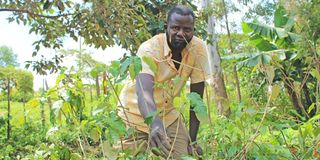Premium
To earn in plenty from native trees, be patient

Nelson Kimeli showcases exotic and indigenous tree seedlings on his farm in Turbo, Uasin Gishu County.
What you need to know:
- The business is labour intensive and requires plenty of water
- Some of the indigenous trees take up to 30 years to mature and are very delicate at the beginning.
- The government ought to come up with ways to promote the growing of indigenous trees and ensure that those who cut them down are punished.
- Elgon teak takes about 20 to 25 years to mature. One should be alive to this fact.
For the past 15 years, Nelson Kimeli has been running a tree seedlings farm in Uasin County, where he grows Nandi Flame, Cedar, Croton megalocarpus, gravellia, eucalyptus, African cherry and Elgon teak, among others.
He tells Stanley Kimuge what it takes to successfully run such a venture
Why are you farming tree seedlings?
Nelson Kimeli: I realised that indigenous trees, in particular, were becoming hard to come by as most people were clearing them to grow exotic ones.
So in 2005, I started with some 700 seedlings then added 8,000 exotic ones since people needed both.
Unfortunately, the entire investment was swept away after the three-acre family land that I farm on, which borders River Kosachei was flooded.
I lost close to Sh100,000 but I started again. Now I have over 20,000 tree seedlings of 30 different species.
Where do you get the indigenous tree seeds?
Nelson Kimeli: To maximise on profits, I source them from forests such as Kiplonik and Kaptembei in Nandi County and in western from Lugari and Kakamega.
I harvest the seeds, then dry them for seven days. One must have permission from Kenya Forest Service to harvest the seeds.
I then grow them in a seedbed. Thereafter, I transplant them in nylon pots. One must control pests, diseases and blight. I avoid commercial seeds because some don’t grow.
Is this a rewarding venture?
Nelson Kimeli: Yes, in a good month, I sell at least 2,000 tree seedlings especially at the onset of rains in March and October.
I sell 200 to 500 trees when the business is low. Exotic tree seedlings at an average of Sh20 and indigenous ones at between Sh30 and Sh40.
Through the business, I have constructed a house and provide for my family and even parents.
How do you market your products?
Nelson Kimeli: I get most of my clients through referrals. I also look for the seeds based on the demand for certain species, which makes it easier to sell. Most people like Red Stinkwood (Prunus Africana).
What are the challenges in your business?
Nelson Kimeli: Pests and diseases as well as blight affect seedlings. Then the business is labour intensive and requires plenty of water, which sometimes is not available.
Some of the indigenous trees take up to 30 years to mature and are very delicate at the beginning but most people don’t know.
When they die, they can claim that you sell inferior seedlings. In this business, I have learnt to be patient since one has to wait from six to nine months to propagate and sell the indigenous seedlings.
Do you foresee a time when indigenous trees growing will pick up?
Nelson Kimeli: The government ought to come up with ways to promote the growing of indigenous trees and ensure that those who cut them down are punished.
Why do people find indigenous trees harder to grow?
Dr Shem Mwasi, an environmental biologist at University of Eldoret: Normally, mature indigenous tree seedlings are less susceptible to pests and diseases.
But in the nursery and after planting in the field, the trees fall to pests and diseases, which feed on leaves and barks.
Roots are also susceptible to attack in some cases. Pest outbreaks occur when conditions are favourable. Croton species are attacked by indigenous insects.
For instance, Amyna punctum damages its leaves while podo can be attacked by the “emperor” insect. This pest mostly defoliates the tree, and it’s very destructive at larvae stage.
Diseases also spread during the growing period. Camphor is often attacked by shoestring root rot. This is a fungal infection that attack trees that are already stressed by other factors.
But under normal circumstances, indigenous or native species do not require intense management when they are growing under local conditions, but because of increased human disturbances in environments, good management is necessary.
Why should one consider when selecting a tree to plant?
Some indigenous trees like Croton and Cordia take up to 30 years to mature and some like for Podo seeds take six months to germinate.
Elgon teak takes about 20 to 25 years to mature. One should be alive to this fact. It is good to note that most of these trees can be used in mixed farming systems and also grown in plantations.





